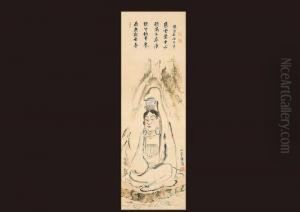Okamoto Ippei Paintings
Okamoto Ippei was a prominent Japanese artist and cartoonist, born in 1886 in Fukuoka Prefecture, Japan. He is best known for his contributions to the development of manga and newspaper comic strips in Japan, blending Western styles with traditional Japanese techniques. His work often reflected the social and cultural changes occurring in Japan during the early 20th century, making him a significant figure in the world of Japanese art and literature.
Okamoto moved to Tokyo in his youth, where he initially pursued studies in English literature at Waseda University. However, his passion for art led him to switch his focus to the world of illustration and cartooning. He began his career as a newspaper illustrator and cartoonist in the 1910s, quickly gaining popularity for his witty and insightful commentary on everyday life and society.
Throughout the 1920s and 1930s, Okamoto's work became increasingly influential, as he explored various themes ranging from political satire to the depiction of daily life in Japan. He was adept at using humor and satire to critique social norms and political issues, making his work both accessible and thought-provoking. His cartoons and illustrations appeared in a variety of publications, including newspapers, magazines, and books, reaching a wide audience across Japan.
Okamoto was not only a cartoonist but also an essayist and a thinker, who wrote on a variety of subjects including art, culture, and politics. His essays often accompanied his illustrations, providing deeper insights into the themes he depicted. He was a prolific artist, whose work continued to evolve until his death in 1948.
Despite the challenges of wartime censorship and the changing political landscape of Japan, Okamoto Ippei remained a beloved and respected figure in Japanese art. His legacy includes not only his vast body of work but also his influence on subsequent generations of manga artists and cartoonists. Okamoto's unique blend of humor, satire, and artistic skill continues to be celebrated, and his contributions to the development of manga and graphic storytelling in Japan are recognized as foundational to the medium.
